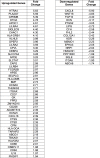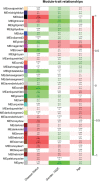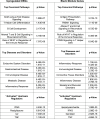RNAseq Analyses Identify Tumor Necrosis Factor-Mediated Inflammation as a Major Abnormality in ALS Spinal Cord
- PMID: 27487029
- PMCID: PMC4972368
- DOI: 10.1371/journal.pone.0160520
RNAseq Analyses Identify Tumor Necrosis Factor-Mediated Inflammation as a Major Abnormality in ALS Spinal Cord
Abstract
ALS is a rapidly progressive, devastating neurodegenerative illness of adults that produces disabling weakness and spasticity arising from death of lower and upper motor neurons. No meaningful therapies exist to slow ALS progression, and molecular insights into pathogenesis and progression are sorely needed. In that context, we used high-depth, next generation RNA sequencing (RNAseq, Illumina) to define gene network abnormalities in RNA samples depleted of rRNA and isolated from cervical spinal cord sections of 7 ALS and 8 CTL samples. We aligned >50 million 2X150 bp paired-end sequences/sample to the hg19 human genome and applied three different algorithms (Cuffdiff2, DEseq2, EdgeR) for identification of differentially expressed genes (DEG's). Ingenuity Pathways Analysis (IPA) and Weighted Gene Co-expression Network Analysis (WGCNA) identified inflammatory processes as significantly elevated in our ALS samples, with tumor necrosis factor (TNF) found to be a major pathway regulator (IPA) and TNFα-induced protein 2 (TNFAIP2) as a major network "hub" gene (WGCNA). Using the oPOSSUM algorithm, we analyzed transcription factors (TF) controlling expression of the nine DEG/hub genes in the ALS samples and identified TF's involved in inflammation (NFkB, REL, NFkB1) and macrophage function (NR1H2::RXRA heterodimer). Transient expression in human iPSC-derived motor neurons of TNFAIP2 (also a DEG identified by all three algorithms) reduced cell viability and induced caspase 3/7 activation. Using high-density RNAseq, multiple algorithms for DEG identification, and an unsupervised gene co-expression network approach, we identified significant elevation of inflammatory processes in ALS spinal cord with TNF as a major regulatory molecule. Overexpression of the DEG TNFAIP2 in human motor neurons, the population most vulnerable to die in ALS, increased cell death and caspase 3/7 activation. We propose that therapies targeted to reduce inflammatory TNFα signaling may be helpful in ALS patients.
Conflict of interest statement
Figures







Similar articles
-
Massive transcriptome sequencing of human spinal cord tissues provides new insights into motor neuron degeneration in ALS.Sci Rep. 2017 Aug 30;7(1):10046. doi: 10.1038/s41598-017-10488-7. Sci Rep. 2017. PMID: 28855684 Free PMC article.
-
RNA-seq analyses reveal that cervical spinal cords and anterior motor neurons from amyotrophic lateral sclerosis subjects show reduced expression of mitochondrial DNA-encoded respiratory genes, and rhTFAM may correct this respiratory deficiency.Brain Res. 2017 Jul 15;1667:74-83. doi: 10.1016/j.brainres.2017.05.010. Epub 2017 May 13. Brain Res. 2017. PMID: 28511992
-
Beta-amyloid 42 accumulation in the lumbar spinal cord motor neurons of amyotrophic lateral sclerosis patients.Neurobiol Dis. 2005 Jun-Jul;19(1-2):340-7. doi: 10.1016/j.nbd.2005.01.012. Neurobiol Dis. 2005. PMID: 15837590
-
Spinal cord molecular profiling provides a better understanding of amyotrophic lateral sclerosis pathogenesis.Brain Res Brain Res Rev. 2004 Jul;45(3):213-29. doi: 10.1016/j.brainresrev.2004.04.002. Brain Res Brain Res Rev. 2004. PMID: 15210305 Review.
-
The molecular link between inefficient GluA2 Q/R site-RNA editing and TDP-43 pathology in motor neurons of sporadic amyotrophic lateral sclerosis patients.Brain Res. 2014 Oct 10;1584:28-38. doi: 10.1016/j.brainres.2013.12.011. Epub 2013 Dec 16. Brain Res. 2014. PMID: 24355598 Review.
Cited by
-
RNA-Seq Analysis of Spinal Cord Tissues from hPFN1G118V Transgenic Mouse Model of ALS at Pre-symptomatic and End-Stages of Disease.Sci Rep. 2018 Sep 13;8(1):13737. doi: 10.1038/s41598-018-31132-y. Sci Rep. 2018. PMID: 30213953 Free PMC article.
-
Selective induction of P-glycoprotein at the CNS barriers during symptomatic stage of an ALS animal model.Neurosci Lett. 2017 Feb 3;639:103-113. doi: 10.1016/j.neulet.2016.12.049. Epub 2016 Dec 21. Neurosci Lett. 2017. PMID: 28011392 Free PMC article.
-
Oxaloacetate treatment preserves motor function in SOD1G93A mice and normalizes select neuroinflammation-related parameters in the spinal cord.Sci Rep. 2021 May 26;11(1):11051. doi: 10.1038/s41598-021-90438-6. Sci Rep. 2021. PMID: 34040085 Free PMC article.
-
Identification of a Transcription Factor Signature That Can Predict Breast Cancer Survival.Comput Math Methods Med. 2021 Feb 19;2021:2649123. doi: 10.1155/2021/2649123. eCollection 2021. Comput Math Methods Med. 2021. PMID: 33688372 Free PMC article.
-
Multiomics Approach Reveal Novel Insights in FUS Driven Juvenile Amyotrophic Lateral Sclerosis: A Family Quartet Analysis.Ann Neurosci. 2025 Apr;32(2):78-89. doi: 10.1177/09727531231194399. Epub 2023 Oct 2. Ann Neurosci. 2025. PMID: 40303507 Free PMC article.
References
-
- Hardiman O, Greenway M. The complex genetics of amyotrophic lateral sclerosis. The LancetNeurology. 2007;6(4):291–2. doi: S1474-4422(07)70062-5 [pii]. - PubMed
MeSH terms
Substances
LinkOut - more resources
Full Text Sources
Other Literature Sources
Medical
Research Materials
Miscellaneous

